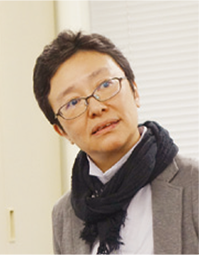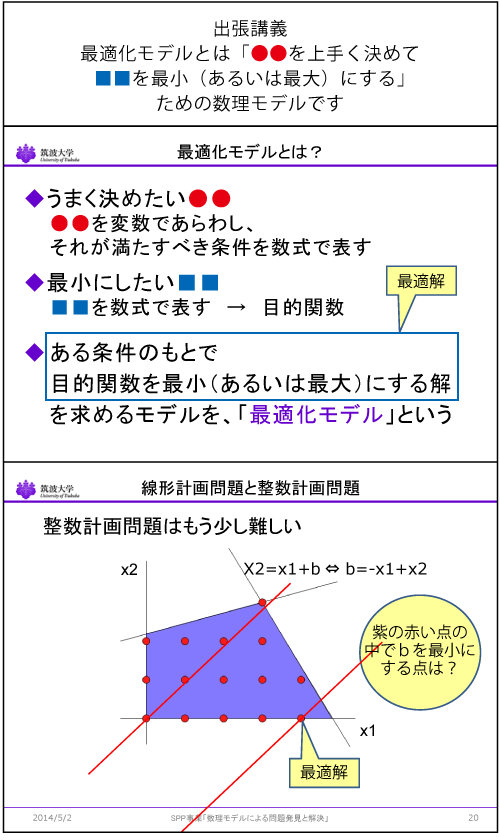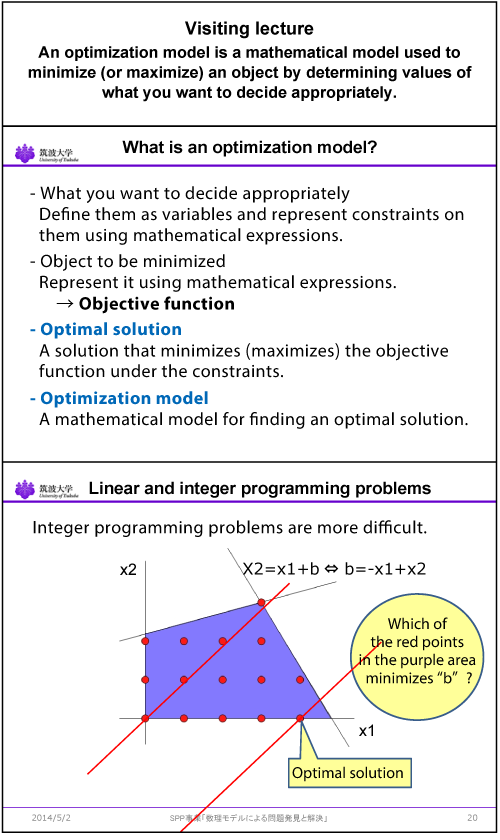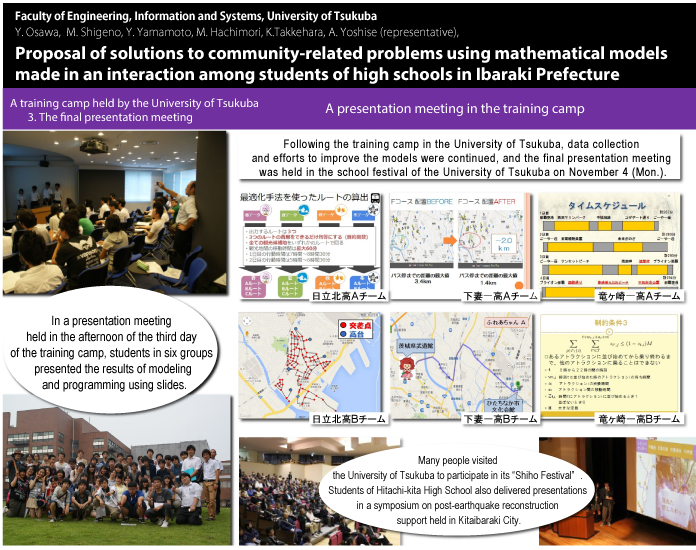キーワード: 最適化モデル、確率モデル、サービス科学、地域連携、オペレーションズ・リサーチ
 産業構造の変化を受け、世界的にサービス産業の重要性が高まっています。日本も例外ではなく、労働者数の約7 割、国内総生産の約8 割がサービス業に占められていることから、サービス産業の成長は、経済政策の要だと認識されています。「サービス資源の最適配分」リサーチユニットでは、最適化モデルや確率モデル等の数理的なアプローチを用いて、人・モノ・情報等のサービス資源を適切な規模で適切に配分できる手法の追及を行っています。
産業構造の変化を受け、世界的にサービス産業の重要性が高まっています。日本も例外ではなく、労働者数の約7 割、国内総生産の約8 割がサービス業に占められていることから、サービス産業の成長は、経済政策の要だと認識されています。「サービス資源の最適配分」リサーチユニットでは、最適化モデルや確率モデル等の数理的なアプローチを用いて、人・モノ・情報等のサービス資源を適切な規模で適切に配分できる手法の追及を行っています。
「 ○○をうまく決めて、■■を最小(あるいは 最大)にしたい!」
をかなえる強力な武器

図1:サービス資源の最適配分の概念図
人・モノ・情報等のサービス資源は、その配分方法がサービスの品質とその効率性に影響することから、企業だけでなく、地域のニーズが高まる自治体の運営にも関係するもっとも基本的な課題です。これらの課題は難しいと捉えられがちですが、じつは、数式を使って解くことができます。たとえば、給食の配給方法も「各給食センターから配送する給食の数をうまく決めて、CO2 の排出量を最小にしたい」と捉えることで、数式化が可能です。これは、経営工学の分野で最適化モデルと呼ばれる数理技術です(図1)。この技術は、乗り換え案内検索にも応用されています。本リサーチユニットでは、最適化モデル、確率モデル等の数理モデルを用いてサービス産業および自治体における、人・モノ・情報等のサービス資源の最適な配分方法について、多角的に研究しています。
「社会問題」x「数理的アプローチ」=「ソリューション想像力」
具体的には、(1)タクシー会社の配車計画、(2)送迎バス運転手のスケジューリング、(3)コミュニティバスの運行計画、(4)災害時の避難経路策定、(5)病院手術室の利用スケジュール、(6)データセンターにおける仮想計算機のパッキング、(7)ホテル業務の従業員割当システム、(8)売店の従業員割当システム、等を題材に、サービスの品質と効率性を高める研究に取り組んでいます。また、単なる実験的な成果に終始することなく、実務的な課題から抽出された数理モデルの構造や性質を理論的な研究として結実させること、社会問題への数理的アプローチを用いた問題解決(ソリューション想像力)の育成にも力を入れています(図2)。

図2:茨城県内の高校交流による数理モデルを用いた地域課題解決提案
社会への貢献・実績
- 病床管理の自動割当システムの開発( 筑波大学附属病院ならびに新日鉄住金ソリューションズ)
- 階層型光ネットワークにおける波長経路割り当てに関する研究(産業総合研究所)
- 国際観光旅館におけるサービス事業の作業効率化に関する研究(筑波山江戸屋)
- 自販機管理事業における作業の疲労度予測と効率化に関する研究(株式会社いいじま)
- 「 最適化の理論と応用ー未来を担う若手研究者の集い2015ー」の開催( 2015年5月30日、5月31日)
- 「 高大連携シンポジウム2014」シンポジウムの開催(2014年11月2日)
取材:平成27年6月26日
Formulas to determine the optimal allocation of service resources
Unit members : Saruwatari, Yasufumi Okamoto, Naohisa Zhang, Yongbing Shigeno, Maiko
Unit name: Optimal Allocation of Service Resources
Key words: optimization model, probability model, service science, community collaboration, operations research
 As the industrial structure changes, the service industry has become increasingly important across the world. Japan is no exception. As the number of people working in this industry accounts for approximately 70% of the total and its product accounts for approximately 80% of the gross domestic product, the growth of the service industry in Japan is viewed as the keystone of its economic policy. The research unit: “Optimal Allocation of Service Resources”, develops methods to allocate appropriate quantities of service resources, including personnel, products, and capitals, in an appropriate manner, using mathematical approaches such as optimization and probability models.
As the industrial structure changes, the service industry has become increasingly important across the world. Japan is no exception. As the number of people working in this industry accounts for approximately 70% of the total and its product accounts for approximately 80% of the gross domestic product, the growth of the service industry in Japan is viewed as the keystone of its economic policy. The research unit: “Optimal Allocation of Service Resources”, develops methods to allocate appropriate quantities of service resources, including personnel, products, and capitals, in an appropriate manner, using mathematical approaches such as optimization and probability models.
An effective tool to determine the optimal value to minimize (or maximize) something

Figure 1: Conceptual diagram of the optimal distribution of service resources
The issues of service resources, including personnel, products, and capitals, is the very basis of the management of both companies and local governments, which address increasing local needs, because the methods for the allocation of service resources influence the quality and efficiency of services. Although these issues may appear to be difficult, they can be addressed using formulas. For example, a method for the distribution of meals by feeding centers can be expressed as a formula based on the idea of “determining the appropriate number of meals distributed by feeding centers to reduce CO2 emissions as much as possible” . This is a mathematical technique referred to as the optimization model in the field of management engineering (Figure 1). It has also been applied to search systems for the provision of information on transfer of transportation. The research unit conducts multifaceted research on methods for the optimal allocation of service resources, including personnel, products, and information, in the service industry and local governments, using optimization, probability, and other mathematical models.
“Social sensitivities” × “Quantitative approaches” = “Power to solve”
We are involved in research on the following subjects to increase the quality and efficiency of services: (1) plans for dispatching developed by taxi services, (2) scheduling for courtesy bus drivers, (3) plans for the operation of community buses, (4) determination of evacuation routes, (5) schedules for the use of operating rooms in hospitals, (6) virtual machine packing in data centers, (7) systems for the assignment of tasks to hotel employees, and (8) systems for the allocation of employees to stores. In addition to obtaining experimental results, the unit also implements theoretical studies on the structures and properties of mathematical models extracted from practical issues, and promotes the solution of social issues using mathematical approaches (power to solve) (Figure 2).

Figure 2: Proposal of solutions to community-related problems using mathematical models made in an interaction among students of high schools in Ibaraki Prefecture
Social contributions and achievements
- Development of an automatic allocation system for bed management (University of Tsukuba Hospital and NS Solutions Corporation)
- Research on the allocation of paths for light waves in hierarchical optical networks (National Institute of Advanced Industrial Science and Technology)
- Research on methods to increase the work efficiency of services provided by an international tourist hotel (Tsukubasan Edoya)
- Research on the prediction of the levels of work-related fatigue in the business of vending machine management (Iijima, Inc.)
- Held a conference: “Theories of optimization and its applications – 2015 Meeting for young researchers who lead the future” (May 30 and 31, 2015)
- Held a symposium: “High School-University Collaboration Symposium 2014” (November 2, 2014)
Interviewed on June 26, 2015
